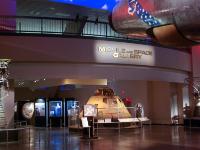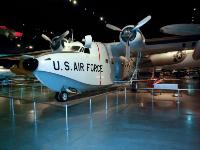Missle and Space Gallery
 1 I now enter the Missile and Space Gallery. At the entrance is the Apollo 15 Command Module accompanied by a pair of LR79 rocket engines. The LR79 was a liquid-fueled engine used to power the Saturn I and IB rockets used in the Apollo, Skylab and Apollo-Soyuz programs. (Saturn V was the launch vehicle for manned Apollo missions and it was powered by different engines) |
 2 Project Apollo achieved six lunar landings between 1969 and 1972, in which 12 astronauts walked on the moon. Of the 29 astronauts who flew Apollo missions, 14 were Air Force officers or had Air Force experience. |
 3 Apollo 15 was the fourth mission to land astronauts on the moon. The crew was Col. David R. Scott (Commander), Lt. Col. James B. Irwin (Lunar Module Pilot) and Maj. Alfred M. Worden (Command Module Pilot). The Apollo 15 mission was launched on July 26, 1971 and was the first to use the Lunar Rover vehicle. |
 4 Gemini bridged the gap between the Mercury and Apollo programs. After two unmanned test flights in 1964, ten manned Gemini missions took place in 1965-1966. Gemini VI and Gemini VII flew at the same time in order to rendezvous in orbit with each other. Gemini VII was flown by Borman & Lovell. During the Apollo program they, along with Anders, were the first astronauts to leave earth orbit and the first to go to the moon. |
 5 During the Gemini program the USAF provided the Titan II boosters and launch crews, flight medicine, facilities and tracking and recovery services. The Gemini Titan launch vehicle was a modified Titan II ballistic missile that was the only booster capable of lifting the Gemini spacecraft into orbit. |
 6 Second from the right is the BOEING LGM-30G MINUTEMAN III Intercontinental Ballistic Missile (ICBM). It is is the U.S.'s only current operational land-based strategic nuclear missile. It is one leg of the nuclear deterrent "triad" that also includes USAF bombers and U.S. Navy submarine-launched missiles. U.S. nuclear forces are on alert at all times, ensuring a swift response in the event of a nuclear attack. There is a display about how this weapon is deployed. |
 7 On the left, the CHRYSLER SM-78/PGM-19A JUPITER was an Intermediate Range Ballistic Missile (IRBM) in service from 1960 to 1963. It was an important link between early, short-range rockets and later weapons that could reach any point on Earth. Next is the DOUGLAS SM-75/PGM-17A THOR intermediate range ballistic missile (IRBM) which resulted from an early early Cold War race to deploy nuclear armed missiles before the Soviets. |
 8 Fourth from the left is the MARTIN MARIETTA SM-68A/HGM-25A TITAN which was the US's first multistage ICBM (Intercontinental Ballistic Missile). It was the first American ICBM to be based in underground silos. Third from the left is the MARTIN MARIETTA SM-68B/LGM-25C TITAN II which was the longest-serving ICBM in the USAF's strategic arsenal. The SM-68B was on operational alert from 1963-1987 and for most of its nearly 25 years of operation, Titan II was the largest and most powerful American nuclear-armed missile. The Titan design also enjoyed a long career as a space launch vehicle, sending satellites and manned spacecraft into earth orbit. |
 9 Near the lift (elevator) is the THOR AGENA A which launched the world's first space photo reconnaissance satellites. These satellites took pictures of the Soviet Union's bomber and missile bases during the Cold War. On the left is the BOEING LGM-118A PEACEKEEPER which was the USAF's most powerful, accurate and technologically advanced intercontinental ballistic missile (ICBM) when it served from 1986 to 2005. It used the latest targeting technology to deliver many independently targeted nuclear warheads. |
 10 The AEROJET-GENERAL LR87 LIQUID ROCKET The LR87 is a liquid rocket engine used on Titan II intercontinental ballistic missiles and space boosters. The engine is a "fixed-thrust" engine which means that it could not be throttled nor restarted in flight. The LR87 delivered approximately 430,000 pounds of thrust using "hypergolic" fuel. Hypergolic fuels are liquids that ignite when mixed together. |
 11 The REACTION MOTORS XLR11 ROCKET was the first liquid-fuel rocket engine developed in the United States for use on airplanes. The engine was first used in the Bell X-1 and on Oct. 14 1947, it became the first airplane in history to fly faster than the speed of sound. |
 12 REACTION MOTORS XLR- ROCKET was the first large, "man-rated," throttleable, restartable liquid propellant rocket engine. The throttle setting could be varied from about 50 percent to 100 percent of thrust, and the restart capability allowed it to be shut down in flight with the assurance that power would again be available later. The XLR99 was one of the rocket engines used in the X-15 manned research aircraft which was capable of propelling man to the fringes of space. |
 13 The V-2 ROCKET engine powered Germany's V-2 "Vengeance Weapon" during World War II. The engine was a technical achievement that used high-speed pumps to move large volumes of fuel into the thrust chamber very quickly. The V-2's liquid oxygen and alcohol propellants produced a thrust of 56,000 pounds which gave the rocket a maximum range of 220 miles, a ceiling of 50-60 miles and a speed of 3,400 mph. |
 14 Germany made about 6,000 V-2s during 1944-1945 and launched more than 2,600 against London, Antwerp, Liege, Brussels, Paris and Luxembourg. This is the high speed pump that fed massive amounts of propellants into the thrust chamber. |
 15 The Apollo 16 mission took place from April 16-27, 1972. The 11-day journey was the fifth mission in which astronauts walked on the moon. Duke and Young flew the lunar module Orion to the moon's surface, while Mattingly orbited above them in the command module, Casper. |
 16 Charlie Duke and John Young stayed on the moon for nearly three days in three EVAs (extravehicular activities). They spent more than 20 hours conducting experiments and collecting over 211 pounds of rocks and soil. Overall, six Apollo missions brought back 841 pounds of lunar samples. These samples, along with lunar surface experiments and space probes, gave scientists new insights on the age and structure of the moon. |
 17 In JOHN H GLENN Jr's long aviation career, he flew with the U.S. Marines and the USAF, set a speed record and shot down enemy aircraft. He is best known as the first American to orbit the Earth and, later in life, as the oldest person to fly in space. |
 18 The MINUTEMAN II MISSION PROCEDURES TRAINER. USAF crews in isolated, heavily protected missile control complexes maintain, secure and operate the Minuteman system. This missile trainer represents Minuteman II systems operational from 1966 through 1991. |
 19 President John F. Kennedy called the powerful new Minuteman his "ace in the hole" because it was the first U.S. underground silo-launched missile. Solid-fuel Minuteman missiles were simpler to maintain and easier to mass produce than liquid-fuel rockets. One thousand were in service by the end of 1967. |
 20 What a simple procedure: Warning, Verification, |
 21 Arm, Launch. By other side of the world I presume they mean Russia. |
 22 Minuuteman is the system in use today. |
 23 This map shows how the missile leaves its silo in American territory and flies over the North Pole to its target on the other side of the world |
 24 The STARGAZER GONDOLA & BALLON was used for high-altitude astronomical investigation from above 95 percent of the earth's atmosphere, permitting undistorted visual and photographic observations of the stars and planets. On Dec. 13-14, 1962, Kittinger and White made a flight to an altitude of 82,000 feet over New Mexico in the Stargazer gondola. |
 25 The balloon that supported the Stargazer capsule was a 280-foot diameter sphere of mylar film. However, at launch only a comparatively small bubble of helium gas occupied the top of the balloon with the remainder of the balloon envelope dangling beneath. As the balloon rose the gas expanded filling the balloon until, at maximum altitude, it was completely filled and reshaped into a sphere. END OF TOUR. GO TO OTHER EXIBITS TO CONTINUE. Next folder: Other Exhibits |
